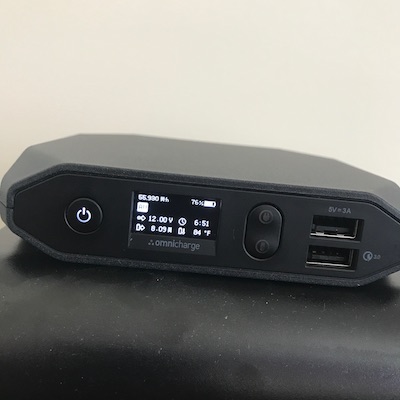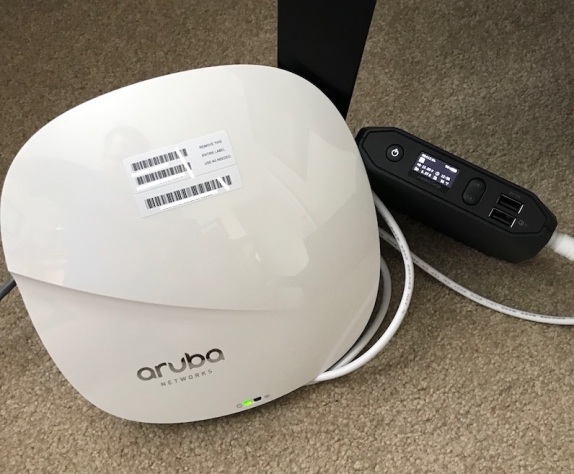Like many other WLAN professionals out there, the one thing that never seems to be available when doing onsite survey work is power. Whether it be to recharge your laptop or power up your access point for an active survey, you can never find an outlet nearby. It’s like someone took into account proper AP placement for the WLAN and conveniently moved every outlet away from that position. In my search to find a mobile power source, I came across the Omnicharge.
The main purpose for my search was to find a portable battery that could be used primarily in an AP-on-a-stick (APoS) kit, and provide enough juice to get me through most average sized surveys. Since most of my active survey work is typically in hospitals and large warehouses, an average sized survey would be around 500,000 square feet (or ~46,500 square meters for those strange metric folks). Based on that, the battery needed to meet the following criteria.
- The battery capacity must be sized to meet FAA regulations for traveling in carry-on baggage. (Click here for the FAA battery FAQ)
- The battery must be small enough to place into my backpack that includes my laptops etc.
- The battery must be capable of providing power to an enterprise class AP for a minimum of 6 hours.
- The battery must provide multiple outlet types for device charging (USB, etc).
For those of you familiar with the WLAN community, industry veteran (and surveyor extraordinaire) Keith Parsons recommends the ReVolt G2 battery pack which by all accounts is a fine battery. While I like the ruggedness of this pack, I wanted something that wouldn’t require a lot of additional pieces like POE injectors, etc and was able to get things up and running quickly. Other sources I have seen lately are bottle-type batteries designed for electric bicycles, that seem to be large enough to power an AP for a month lol. For me this wasn’t an option due to requirement #1.
The Omnicharge device that I decided to go with comes in just under $300 at the time of writing. I was able to get in on the kickstarter funding phase and was able to get the Omnicharge 20 for ~$200. The Omnicharge 20 comes in at a measly 1.4 pounds yet boasts an impressive 74wH (20,400 mAh) of power.

Omnicharge 20
The one thing about this device that got me really excited was the inclusion of a built-in AC power socket that allows you to plug in any normal 120VAC plug without the need of a separate inverter. Another useful feature was the DC barrel port used for recharging the battery pack itself, can be reversed and provide variable voltage DC out. That’s right folks, variable DC output between 1V-24V that is user selectable via the onboard controls. This is perfect for being able to operate an AP via DC power that provides much more efficient power usage and longer runtime from the battery pack. I won’t bore you with anymore details of the unit as you can check it out using the link at the beginning of the article.
Now onto the testing…

Omnicharge 20 powering Aruba IAP-325 via 12VDC output
For this test, I took an Aruba IAP-325 and connected it to the Omnicharge pack and set the DC power output to the required 12V. (Be sure to check your AP manufacturer data sheet for the required power input to the AP.) For testing purposes, I set the IAP to broadcast an SSID on both the 2.4 GHz and 5 GHz radios at a power output of 12dBm. The AP also had an ethernet uplink to my lab network for statistical reporting to the Aruba Airwave management appliance. Power draw from the AP under these conditions was approximately 8.5W throughout the experiment. I checked draw with and without the ethernet port active, and less than .1W difference was noticed so it is assumed this draw is negligible for testing purposes.
As you will see in the attached graph, the runtime for the AP under these test parameters was an astounding 9 hours and 18 minutes.

For me this, was quite surprising considering the size and weight of this battery pack. However, for my purposes this is more than enough for an average day of survey work. After having done some surveys where I walked 6 miles in 4 hours, I would hate to think about using this battery for it’s full lifespan. The discharge rate as you can see was very consistent and lacks the steep drop-off along the way as I have seen from other battery packs over the years. The device is rated to provide at least 70% of the original capacity after 500 charging cycles. Even with this depletion, it would still provide over 6 hours of runtime for this same test setup.
I would highly recommend that if you are looking for a good battery pack with a lot of options check this one out.
-Scott
Note: This review was not sponsored by Omnicharge or any of its affiliates. The device tested was purchased by the author for personal use.



Pingback: In search of juice…power that is. | Omnicharge
Great write up on the Omni 20. Quick question. What cable are you using between the Aruba AP and the Omni 20 in the photo in the post?
Also, congrats on the CWNE!
LikeLike
It was a two part cable. https://www.amazon.com/gp/product/B01M9ET8QW/ref=oh_aui_detailpage_o08_s00?ie=UTF8&psc=1 for the cable itself and https://www.amazon.com/gp/product/B00IYYVF26/ref=oh_aui_detailpage_o08_s00?ie=UTF8&psc=1 for the adapter. I bought the male to female cable so i could just swap ends for different APs. And thanks on the CWNE.
LikeLike
http://www.veracityglobal.com/products/ip-camera-installation-tools/pointsource-plus.aspx this is what i use.
LikeLike